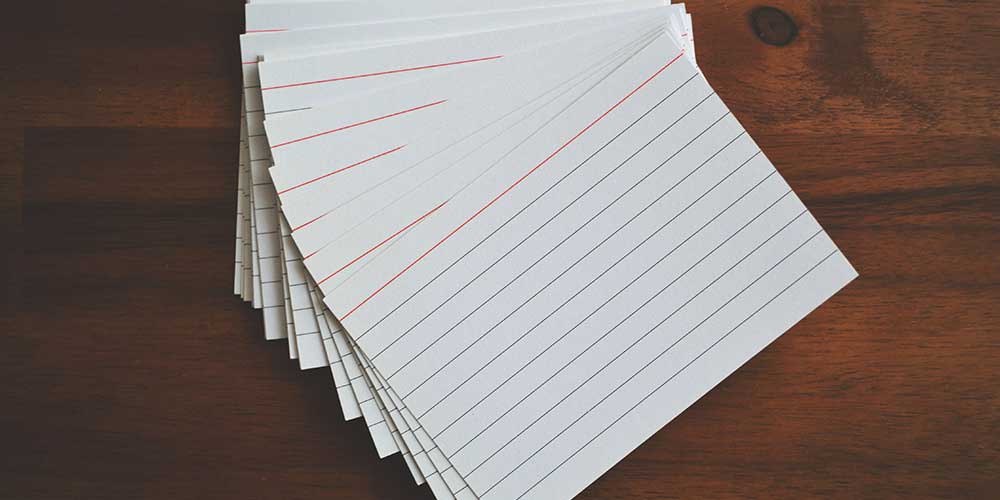Contents
- What are revision flashcards?
- How to make flashcards for revision
- Is using revision flashcards enough?
- Best online flashcard makers
Revision is one of the most important stages of exam preparation. It often ends up deciding how well you are going to score in an exam. Therefore, choosing the right revision strategy is crucial. 🙋
The wrong strategy might make you doubt yourself despite having studied hard. The last thing you want is to feel underconfident and overworked.
Revision flashcards are one of the best revision strategies. These flashcards condense information into small, bite-sized chunks that you can easily process and remember. Using different colours and images with these flashcards helps emphasise important information in a way that allows it to register in the brain.
You can make your own revision flashcards using online templates or you can buy blank revision flashcards and then just fill them up with your information. Let’s take a look at what websites help share flashcards, how to make revision cards online and how to use revision cards. 👇

What are revision flashcards?
Revision flashcards are small, double-sided cards that emphasise key information. They usually mention a topic or question on one side and important details – like keywords, mnemonics, or the answer on the other. This helps the brain make better connections between those two pieces of information. 🧠
These flashcards can be altered in a number of different ways in order to make them unique and memorable. Exam revision cards can include:
Images
Drawing an image related to the question or keywords can help you to memorise it better. The human brain is excellent at remembering images and tends to associate with them in a broader manner than simple text. 🖼️
Colours
If used wisely, colours can greatly enhance your revision flashcards. You can vary the paper colour, pen-ink or highlighter in order to create combinations that stand out. Studies show that most people remember things written in red better than things written in blue. Bright colours like orange and yellow can be used to highlight important phrases. 🦚
Mnemonics
Now, they don’t work for everyone, but mnemonics – like rhymes, acronyms, phrases, wordgames or memorable sentences – have proven to be an excellent learning tool for some. They help condense a lot of information into simple phonetic words, abbreviations, limericks, etc., that are much easier to remember. 🤔
How to make flashcards for revision
Using revision flashcards is not about bombarding your brain with information – there needs to be a method to the madness! Using certain techniques in an efficient, time-effective manner can help you streamline your entire revision process. Here are a few tips to help you to get the most out of your revision flashcards:
One idea per card
Most people who use revision flashcards try to fit in too much information on them. A revision card is supposed to be a bite-sized factoid that your brain can digest and remember with ease. Try to break down complex topics into several simple thoughts, each of which gets its own card. 🟨
Keep your sentences short
Your revision flashcards don’t even need to have full sentences on them. Using an appropriate amount of keywords to convey an idea makes a flashcard work best. After you are done creating the flashcards, review the information on them and strike out any details that seem unnecessary. 👌
Keep them small
As a rule of thumb, revision flashcards are supposed to be ‘pocket-sized’. Anything bigger than that becomes a hassle to manage and will become less effective. What’s more, pocket-sized flashcards can be flipped through and carried anywhere easily. 🤏
Use spaced repetition
Spaced repetition – revising information over and over with the time intervals increasing each time – is one of the most successful revision strategies. It involves testing how much you remember at frequent intervals to help reiterate information and recall the information you are learning. ⏱️
Assess your learning
Once you are done testing, you can separate your flashcards into three separate piles – ‘Confident’, ‘Needs more practice’ and ‘Needs a lot of practice’ – this way you can critically assess our own progress. 🤓
This is how to revise flashcards. The third pile will contain the topics you are unsure about and will need to be revised and tested the most frequently. Once you are confident about the topics from that pile, they can be moved to the other two until you’ve committed them all to memory.
Is using revision flashcards enough?
In most cases, no. While knowing how to use revision cards is a great learning tool for certain topics, others may require more engaging approaches. Subjects like organic chemistry that require you to picture everything in 3D might be better revised with pictures, videos and 3D models.
Other revision techniques like mind maps, quizzes, flowcharts, etc., can also be used to supplement revision flashcards depending on the topic. The goal should be to find the combination that helps you revise best. ✍️
The most important thing is to start early. Ideally, you should prepare for your exams with enough time to go through several rounds of revision. This will help you to retain more information and perform better on exams.
Best online flashcard makers
If you are looking to make your own revision flashcards online, there are plenty of websites and tools available to help you save some time. What is the best online flashcard maker? Hard to say, it depends on your personal requirements! Whether it’s blank revision cards you’re after or premade, subject-specific suggestions – check out these helpful sites:
Remember, there are plenty of people around you and resources available to turn to – including dedicated GoStudent revision tutors! Why not sign up for your free trial lesson today to see how GoStudent can help you prepare for your exams today. 🎒









